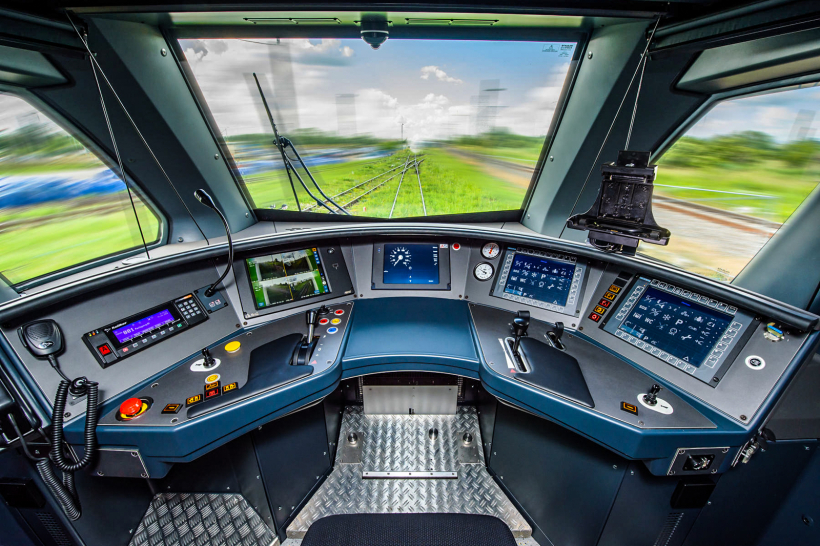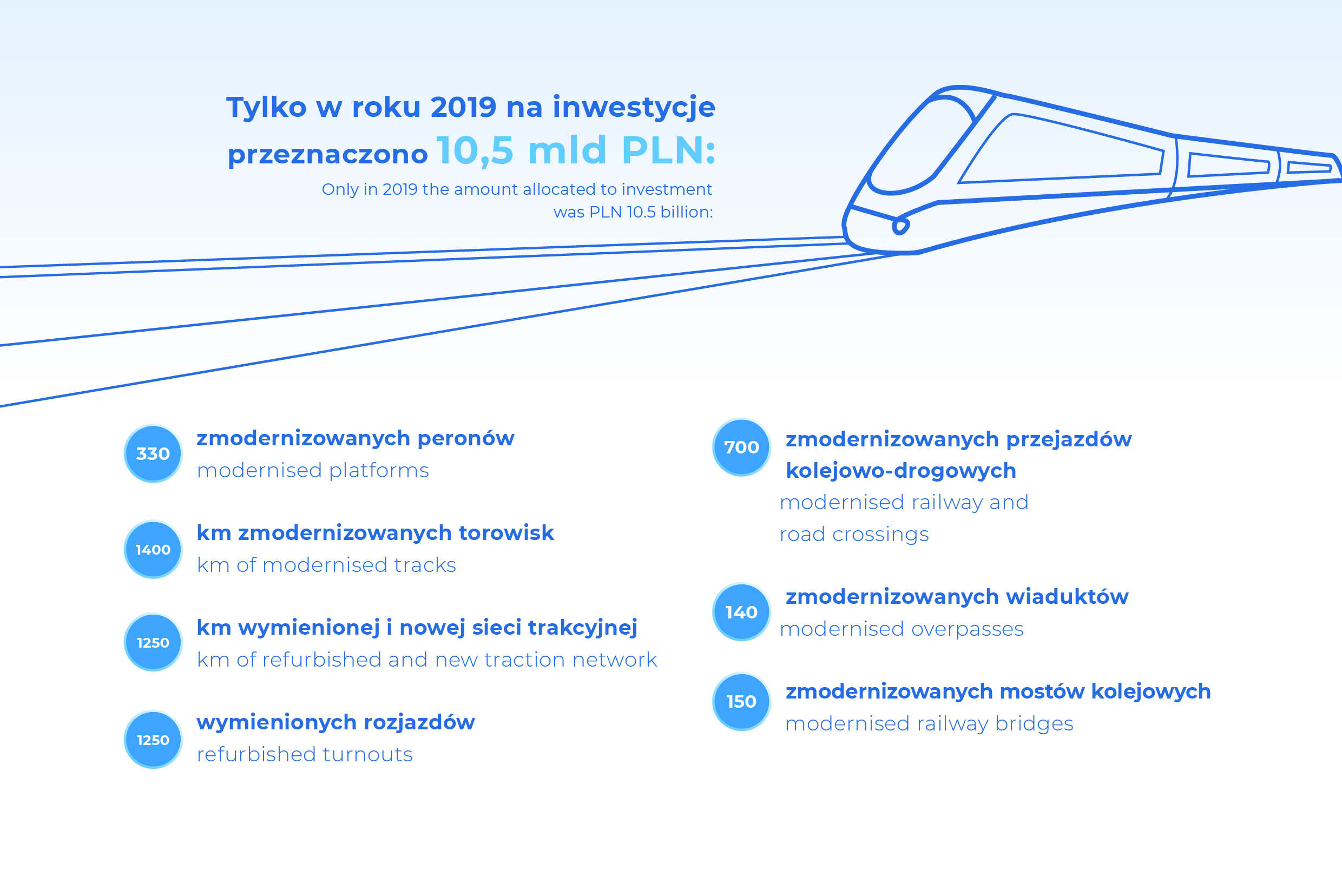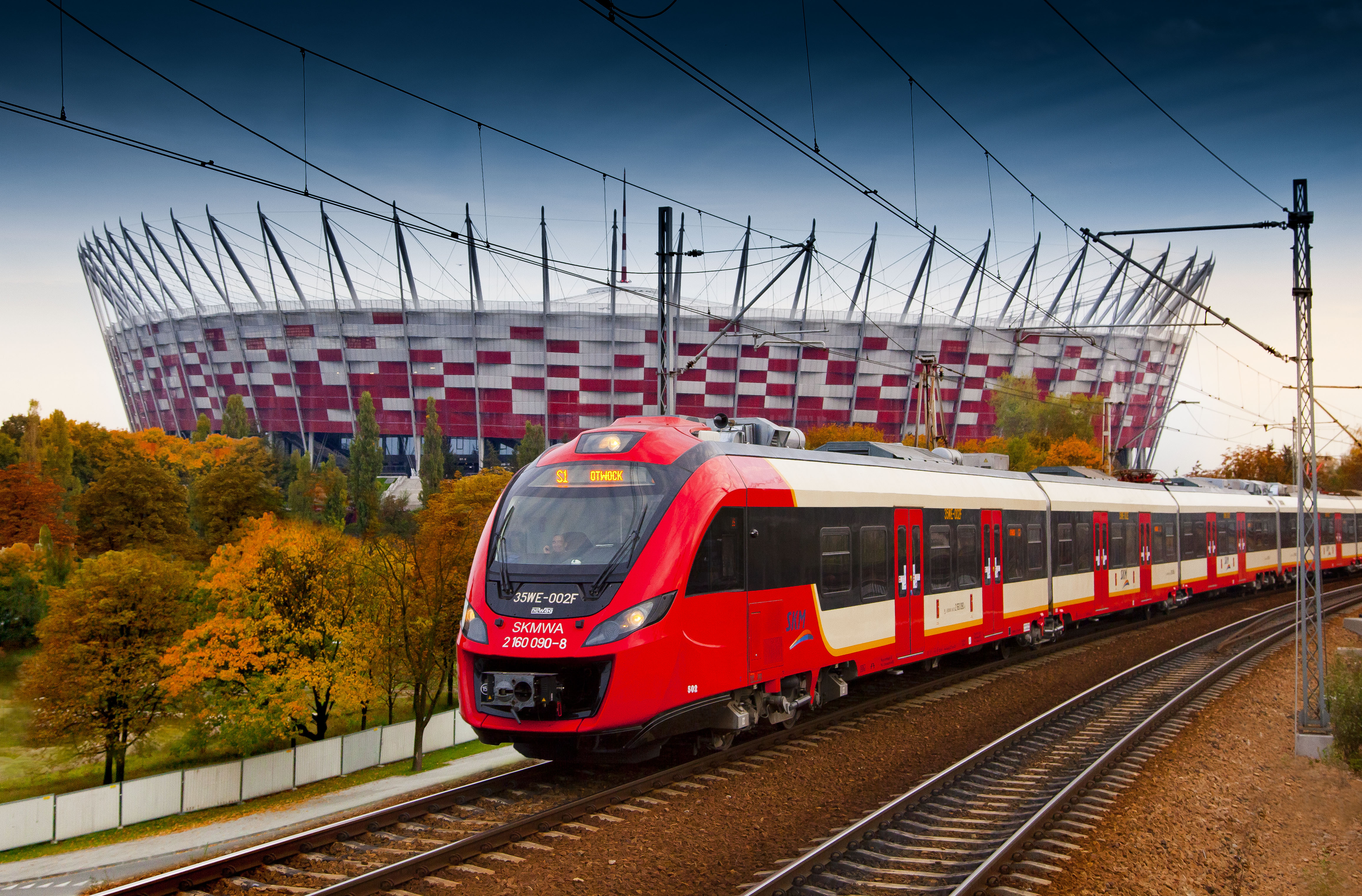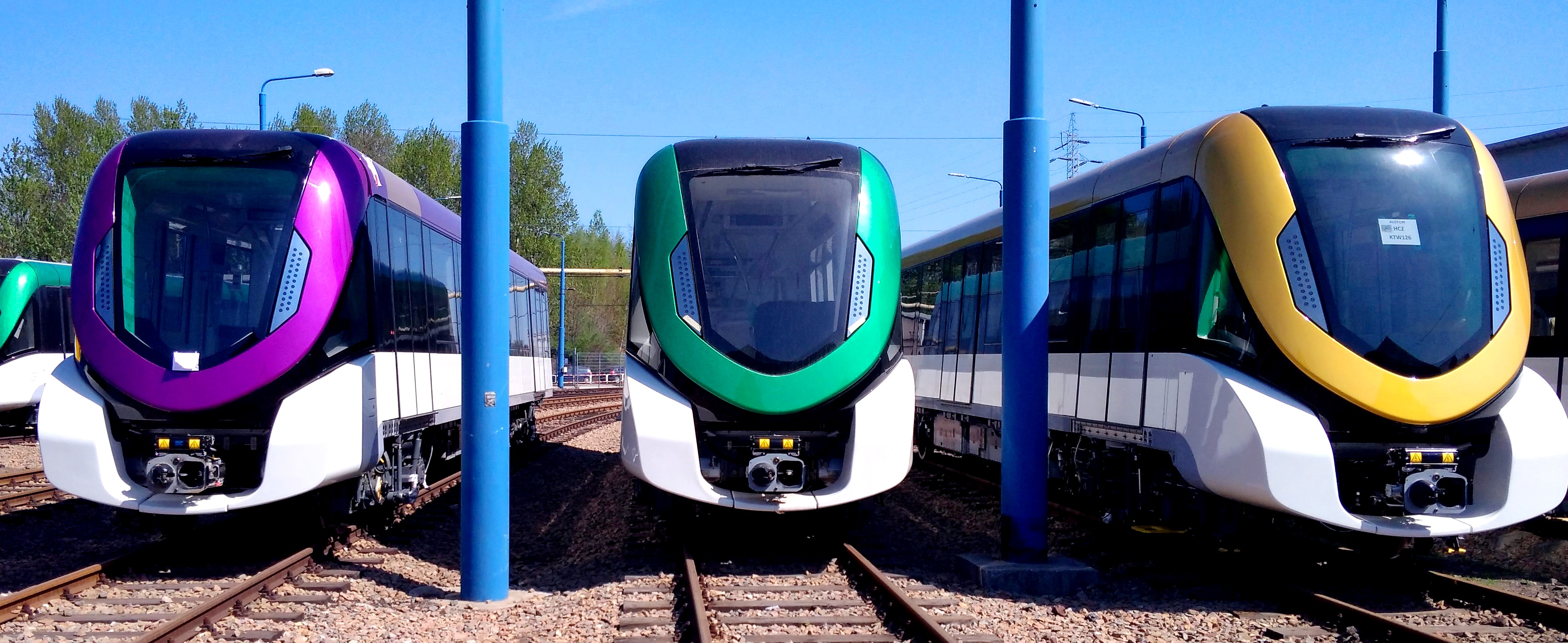
The interior of the driver's cabin of a Stadler train
Railways in Poland
December 29, 2020

The interior of the driver's cabin of a Stadler train
Solidarity Transport Hub
The Solidarity Transport Hub (CPK) is a projected transfer hub between Warsaw and Łódź to integrate air, railway and road transport. According to the project assumptions, the Solidarity Airport will be built in Stanisławów, 37 km west of Warsaw. At the first stage it will be able to provide its services to 45 million passengers a year. The investment is expected to be completed by 2027. The CPK project will also involve railway investments: a railway junction in close proximity of the airport and railway connections throughout Poland to allow travelling from Warsaw to other major Polish cities within maximum 2.5 hours.
The railway part of the CPK Programme anticipates building 1600 km of new lines from 10 directions to the Solidarity Airport and to Warsaw. Each of them will comprise new sections of the network and refurbished or modernised elements of the existing infrastructure. For the needs of building this railway system, investment tasks were distributed among two companies – CPK and PKP PLK. At stage zero, which should be ready before Solidarity Airport is operable, 140 km of new lines will be built, mainly on the route Warsaw-CPK-Łódź. The time horizon for other railway investments is 2040. The concept assumes the following costs: air component up to PLN 16-19 billion, railway component – PLN 8-9 billion and road component – from PLN 1.75 billion to PLN 6.87 billion. Total completion of the main assumptions of the document will cost from PLN 30.9 to 34.9 billion. In view of the differences in the nature of respective components, a different funding strategy may be considered for each of them.

Sustainable Transport Development Strategy
The “Sustainable Transport Development Strategy until 2030”, presented by the minister of infrastructure, was adopted in September 2019. The main goal of this programme is to increase transport accessibility of Poland and improve safety of traffic users and efficiency of the transport sector by creating a cohesive, sustainable, innovative and user-friendly transport system at the national, European and global level. The achievement of this goal will result in convenient conditions fostering stable economic development of Poland.
For the purposes of the main goal, the following are planned until 2023: construction of an integrated and interlinked transport network to support competitive economy; improving methods of organisation and management of the transport system; changes in individual and group mobility (including promotion of public transport); improving safety of traffic users and transported goods; reducing negative environmental impacts of transport; increasing the efficiency of expenditure of public funds on transport projects. These measures need to be implemented in order to make up for past negligence and catch up with new technological and economic trends in Europe and around the world. In the first place, investing efforts will focus mainly on making up the infrastructural backlog through increasing transport accessibility in Poland (roads, railways, airports, inland waterways, sea and inland ports) and organising the core infrastructure for an integrated transport system.

SKM passenger train entering Warszawa Stadion station
Railway Station Investment Programme
The Railway Station Investment Programme (PID) provides for the reconstruction or construction of about 200 railway stations. Its value is estimated to exceed PLN 2 billion. Most projects will be financed by the European Union under the Operational Programme Infrastructure and Environment, Operational Programme Eastern Poland and Regional Operational Programme. Funds for other investments will be sourced from the state budget and from PKP S.A. This is the largest project in the history of PKP S.A. Its main goal is to improve the quality of passenger service at railway stations in smaller localities. An important group is railway stations in satellite towns in the largest urban areas in Poland but the list of railway stations covered by the programme also contained cities such as Białystok, Olsztyn, Kielce and Poznań. The largest investment project under PID is comprehensive modernisation of the historic railway station Gdańsk Główny. The total value of the project is nearly PLN 100 million.
In 2016-2020 as many as 18 railway stations, worth PLN 174 million in total, were put into operation. Approximately half of all railway stations covered by PID are under the supervision of conservation officers. Modernisation restores historic buildings to their former splendour and provides new functionalities to passengers, e.g. facilities for people with limited mobility and disabilities. New facilities, so called Innovative System Railway Stations, are also built under the Railway Station Investment Programme. This is a project authored by PKP S.A. The plan provides for erecting new, one-storey buildings employing “green” solutions such as: PV panels, rainwater harvesting for toilet flushing, LED lighting, and heat pumps. Innovative System Railway Stations will replace big non-functional buildings that do not meet the contemporary requirements of passengers. The company intends to build about 40 such railway stations by 2023.
Railway Plus
The Railway Plus Programme aims at complementing the railway network with connections to localities with more than 10 thousand inhabitants lacking access to passenger transport connections to voivodeship capitals or having access to railway connections that need improvements. The Programme is mainly targeted at local government units /metropolitan transport associations interested in developing railway infrastructure within their area, at the same time taking the transport needs of the local inhabitants into account. The Programme provides for line investments – i.e. modernisation of the existing or construction of new railway lines, as well as single-site investments, e.g. construction of new railway stops, passing loops and rail links. PKP PLK closed the call for applications under this Programme. There are 96 applications and they were sent from all voivodeships. They include overhauls, restoration or construction of new railway lines as well as construction of new railway stops, passing loops and railway links.
The applications were submitted by regional governments, district offices, municipalities and associations. The largest number of applications was received from: Silesian (19), Subcarpathian (11), Lesser Poland and Masovian (9) and Lubusz (8) voivodeships. Other applications were submitted by: Warmian- Masurian and Kuyavian-Pomeranian (6), Lower Silesian, Lublin and Greater Poland (5), West Pomeranian (4), Łódź, Podlaskie, Świętokrzyskie, Pomeranian (2) and Opole (1) voivodeships. The budget of the Programme is PLN 6.5 billion, including approx. PLN 5.5 billion from the state budget (85%), and approx. PLN 1 billion from local government funds (15%). The submitted applications refer to projects worth approximately PLN 25 billion. This amount is four times higher than anticipated by the Railway Plus Programme. The applications refer to about 2 thousand km of railway lines. The proposals included new routes, routes not used for years or those used for freight transport only.
Seventy-one applications refer to so-called line projects (i.e. modernisation, refurbishment, reconstruction or construction of new railway lines), and twenty-five of them covered single-site projects (i.e. railway links, passenger service infrastructure – platforms, stops, railway traffic controls, and alteration of track systems). The applications will be evaluated for compliance with formal requirements to determine their eligibility for the next stage. Later, local governments will have 12 months for developing a preliminary planning and forecasting study. When the second stage is completed, the projects will be evaluated according to multiple criteria, based on which they will be included in a ranking and their eligibility for the Programme will be determined. The completion of the Programme is planned by 2028.

Modern rolling stock manufactured by French company Alstom
Rolling Stock Modernisation
In December 2017, PKP Intercity adopted a new rolling stock strategy for 2016-2020 with a perspective until 2023. The carrier will allocate more than PLN 7 billion for its implementation. Funds will be provided from various sources, including the company's own financial resources, money from recapitalisation of PKP S.A. and funding by third-party institutions. PKP Intercity also intends to obtain EU funding – nearly PLN 790 million. The programme covers modernization and purchase of wagons, locomotives and electric multiple units (EMU). Some of them will be adapted to the speed of 200 km/h or higher.
After the programme is completed, PKP Intercity trains will consist of new or modernised rolling stock in nearly 80%. Moreover, about 80% of the passenger rolling stock will be equipped with electrical sockets, 94% will be air-conditioned, and at least 77% will offer Wi-Fi access to passengers. In addition, every train will provide a space for people in wheelchairs and a bicycle area. The company started cooperation with the National Centre for Research and Development with regard to drafting innovative rolling stock projects. Under the innovation partnership, together with manufacturers and research institutes, PKP Intercity plans to complete three rolling stock projects. The result will be vehicles best suited to the needs of a long-distance carrier. Purchases planned by the end of 2023 include: 25 electric locomotives, 7 electric multiple units and 2 push-pull units. The vehicles should be adapted to speeds from 160 to 230 km/h. Ultimately, the carrier intends to acquire: 38 electric multiple units, 52 electric locomotives and 15 push-pull units. Under the rolling stock modernisation strategy, by 2023 PKP Intercity will modernise more than 700 carriages and buy 185 new ones. These will include carriages with and without compartments, first- and second-class, restaurant cars and bicycle transport carriages, multi-purpose COMBI carriages and carriages with a “Little Traveller Zone”. In addition, passengers will travel on board of 19 new and 14 modernised electric multiple units and two push-pull units. Both, the carriages and electric multiple units will have Wi-Fi access, comfortable chairs, air-conditioning and facilities for families and passengers travelling with their bikes. The vehicles will be adapted to the needs of disabled people in wheelchairs or passengers who are blind or visually impaired.
In addition, PKP Intercity will purchase 118 electric locomotives (single- and multi-system) and diesel locomotives, and modernise nearly 200 electric and diesel locomotives (EU/EP07, EP08 and SM42). Some locomotives, carriages and EMUs will be adapted to 200 km/h or higher speeds. Modernisation of 16 parking stations is also planned under the strategy. The rolling stock purchased under the strategy will be used for connections in Poland and Europe, including: Szczecin-Tricity-Olsztyn-Białystok, Wrocław/Zielona Góra-Poznań-Gdynia, Przemyśl-Lublin-Warsaw-Bydgoszcz-Gdynia/Piła-Kołobrzeg/Gorzów Wlkp., Wrocław-Częstochowa-Kielce or Warsaw-Poznań-Berlin and Warsaw-Katowice-Prague. New and modernised rolling stock capable of developing 160 km/h and higher speed will contribute to considerable savings. At higher speeds the costs per one passenger kilometre are lower. This is associated with both increasing the efficiency of the rolling stock with simultaneously growing daily travelling distance, and the possibility of increasing the transport service. Furthermore, a reduced consumption of electricity and an energy recovery system will contribute to improving the energy efficiency of locomotives. Refurbishment of the rolling stock park is also an element of environmental protection measures due to reducing noise and pollution caused by diesel engines and sanitary systems. Following the completion of the programme, about 98% of PKP Intercity trains will be equipped with closed-system toilets. In 2015, PKP Intercity completed a programme of rolling stock investments worth nearly PLN 5.5 billion. Purchases made under the projects include new Pendolino, FLIRT3 and Pesa DART trains. In September 2016, the carrier prepared a new rolling stock strategy for 2016-2020 planning to invest approx. PLN 2.5 billion in rolling stock and a technical supply base.

Inside a cinema carriage
Multi-annual programme
In 2018, it was resolved to adopt a multi-annual programme titled Support to the extent of financing the costs of rail infrastructure management, including its maintenance and repairs, until 2023. The maintenance programme assumes ensuring adequate quality of rail infrastructure, eliminating maintenance backlogs, preserving the network of railway lines and signing long-term railway line maintenance and repair contracts. Its task is to enhance the role of rail transport in the integrated transport system in Poland by reversing a downward trend in the share of rail transport in overall transport and providing necessary means to carry out maintenance and repair works on the existing railway network.
The programme will be financed from the state budget and the Railway Fund. In 2019-2023, approx. PLN 23.8 billion of public funds will be allocated for its implementation, including approx. PLN 21 billion from the state budget. It will ensure long-term financing for the costs of rail infrastructure management until 2023, especially in the area of maintenance and repairs, incurred by rail infrastructure administrators. The implementation of the programme will contribute to improving the quality of rail infrastructure, which will boost the competitiveness of railway transport. The costs of rail infrastructure management will be financed under a multi-annual agreement between infrastructure administrators and the minister of transport. It will be concluded for 5 years, including one year of budget financing. The programme, under which long-term railway line maintenance and repair contracts can be concluded, will result in more effective planning and contracting maintenance and repair works on a multi-annual basis. This way, the domestic market of contractors (mainly building companies) will be able to prepare better for handling repair and maintenance programmes. The implementation of the programme will partially eliminate the backlog of maintenance and repair works on the railway network managed by PLK. New categories of railway lines will be assigned, which will prevent a degradation of some of them and, as a result, contribute to improving the attractiveness of previously marginalised areas to investors.